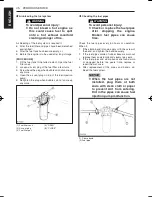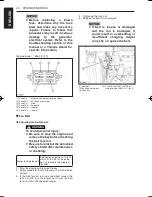
41
E
N
G
L
IS
H
PERIODIC SERVICE
Checking radiator hoses and clamps
WARNING
To avoid personal injury:
8
Be sure to check radiator hoses
and hose clamps periodically. If
radiator hoses are damaged or
coolant leaks out, overheating
can occur.
Check to see if radiator hoses are properly fixed every
200 hours of operation or 6 months, whichever comes
first.
1. If hose clamps are loose or water leaks, tighten
hose clamps securely.
2. Replace hoses and hose clamps if radiator hoses
are swollen, hardened or cracked.
Replace hoses and hose clamps every 2 years, or
earlier as required, if hoses are found to be swollen,
hardened or cracked.
(1) Radiator hose
(2) Hose clamp
Precaution at overheating
The event that the coolant temperature is nearly or
more than the boiling point is called
“OVERHEATING”
.
While running, make the following checks to see that
all parts are working correctly.
If anything is unusual,
inspect it, referring to the relevant description
in “SERVICE INTERVALS” and “PERIODIC
SERVICE” section.
8
Coolant
If the coolant temperature warning lamp lights up or
if steam or coolant does not stop squirting from the
radiator overflow pipe, turn off the load and
keep
the engine idling (COOLING-DOWN) for at least
5 minutes
to let it cool down gradually. Then stop
the engine and take the following inspection and
servicing.
1. Check to see if the coolant runs short or if there is
any coolant leak;
2. Check to see if there is any obstacle around the
cooling air inlet or outlet;
3. Check to see if there is any dirt or dust between
radiator fins and tube;
4. Check to see if the fan belt is too loose; and
5. Check to see if radiator water pipe is clogged.
Cleaning radiator core (outside)
If dust is between the fin and tube, wash it away with
running water.
NOTICE
8
Do not clean radiator with
firm tools such as spatulas or
screwdrivers. They may damage
the delicate fins or tubes. It can
cause coolant leaks or decrease
cooling performance.
8
Be careful to keep water off of
electrical parts.
Cleaning the radiator
Clean the cooling system of the engine every 500
hours.
In addition, clean it before adding anti-freeze and
before stopping use of anti-freeze.
Anti-freeze
WARNING
To avoid personal injury:
8
When using anti-freeze, put on
some protection such as rubber
gloves.
8
When anti-freeze comes in
contact with the skin or clothing,
wash it off immediately.
8
DO NOT mix different types of
anti-freeze.
8
Keep fire and children away
from anti-freeze.
8
Be mindful of the environment
and ecology. Before draining
any fluids, find out the correct
way of disposing by checking
with local codes.
8
Also, observe the relevant
environmental
protection
regulations when disposing
of oil, fuel, coolant, filters and
batteries.
If coolant freezes it can damage the cylinders and
radiator. It is necessary, if the ambient temperature
falls below 0°C (32°F), to either drain coolant after
operating or to add anti-freeze to it.
1. There are two types of anti-freeze available; use
the permanent type (PT) for this engine.
2. Before adding anti-freeze for the first time, clean
the radiator and engine interior by pouring fresh
water, and draining it a few times.
9CN-9-U1-E0.indd 46
2013/11/19 13:50:55
Summary of Contents for EDL11000SDE
Page 2: ......















































